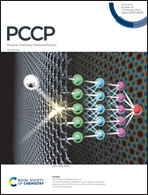Low-lying states of MX2 (M = Ag, Au; X = Cl, Br and I) with coupled-cluster approaches: effect of the basis set, high level correlation and spin–orbit coupling†
Abstract
Theoretical study of coinage metal dihalides is challenging due to their complex electron correlation and relativistic effects, particularly the spin–orbit coupling (SOC) effect. Furthermore, vibrational frequencies and characters of their low-lying states are affected by the Renner–Teller effect (RTE) and pseudo-Jahn–Teller effect (PJTE). The theoretical results depend on the basis set and how the electron correlation is treated and previous results even differ qualitatively in the ground state for some silver dihalides. The equation-of-motion coupled-cluster method at the singles and doubles level (EOM–CCSD) for ionization potentials is employed in this work to calculate electron affinities and vertical excitation energies of MX2 (M = Ag, Au; X = Cl, Br and I) as well as structures, harmonic frequencies and adiabatic excitation energies for the lowest two states of these molecules. Effects of the higher level correlation, basis set as well as SOC on these results, particularly on the πu bending mode frequencies of the 2Πg state, are investigated. A new assignment for photodetachment spectroscopy of AuCl2− is proposed where contribution of the 2Δg state is considered. The ground state of AgCl2 is calculated to be the 2B2 state of the C2v structure in scalar-relativistic (SR) calculations, while the SOC quenches the RTE and PJTE and the ground state becomes the 2Π3/2g state of the D∞h structure. As for the other molecules, the ground state is calculated to be the 2Πg state in SR cases, and the 2Π3/2g state with SOC. Our results indicate that a higher level electron correlation, large basis set and SOC are important to achieve reliable results for these molecules.

- This article is part of the themed collection: 2020 PCCP HOT Articles


 Please wait while we load your content...
Please wait while we load your content...